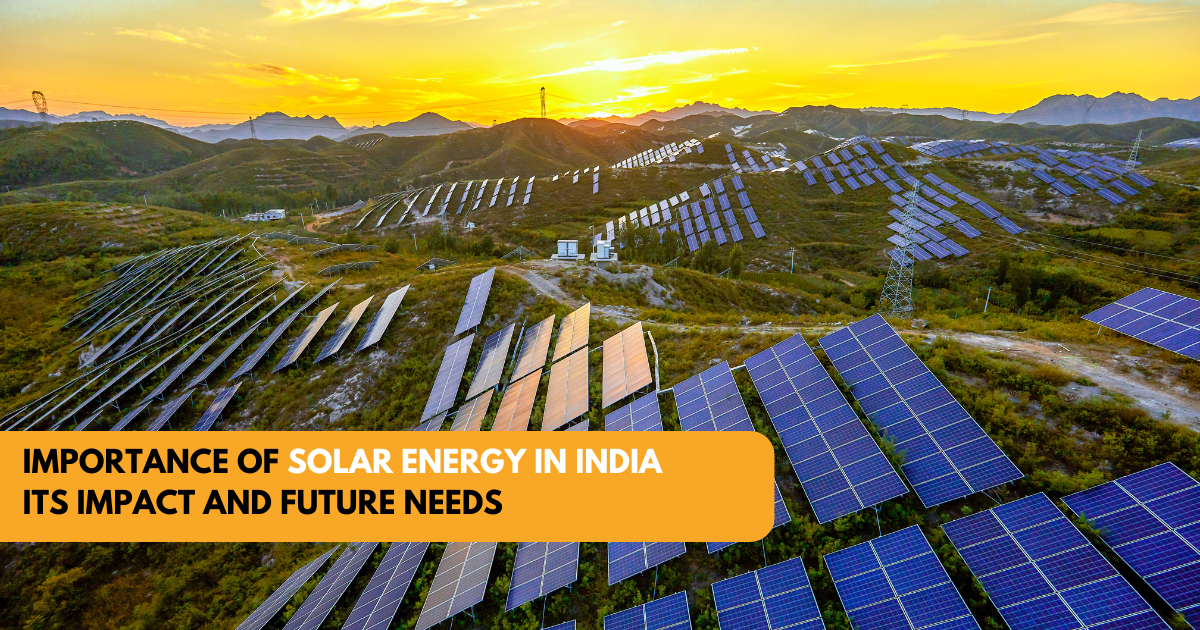Importance of Solar Energy in India: Its Impact and Future Needs
admin
March 30, 2025

Importance of Solar Energy: India, as one of the world’s fastest-growing economies, faces a dual challenge—meeting its rising energy demands while ensuring environmental sustainability. With a population exceeding 1.4 billion and an increasing rate of urbanization, the country’s dependence on fossil fuels has led to mounting concerns over energy security, rising import bills, and environmental degradation. In this context, solar energy has become an important part of India’s energy basket, offering a clean, renewable, and abundant alternative to traditional power sources.
India is uniquely positioned to harness solar power, receiving an average of 300 sunny days per year and an estimated 5,000 trillion kWh of solar radiation annually. Recognizing this potential, the Indian government has undertaken ambitious initiatives, such as the National Solar Mission, aiming for 280 GW of installed solar capacity by 2030 as part of its commitment to achieving net-zero emissions by 2070. Large-scale solar projects like the Bhadla Solar Park in Rajasthan (2,245 MW) and innovative solutions like floating solar farms demonstrate the country’s progress in adopting solar energy.
However, despite these advancements, significant challenges remain, including high initial investment costs, energy storage limitations, and infrastructure gaps in rural areas. This article explores the current state of solar energy in India, its advantages, challenges, and the way forward to make solar power the backbone of India’s energy ecosystem.
Why is Solar Energy Important for India?
Solar energy holds immense significance for India due to several factors:
Energy Demand and Supply Gap
India’s power demand is expected to reach 817 GW by 2030. Solar energy can help bridge the supply gap sustainably.
Environmental Benefits
The country aims to reduce carbon emissions by 1 billion tons by 2030, and solar energy plays a crucial role in this goal.
Energy Security
India still relies on coal and oil imports. Expanding solar energy reduces dependency on fossil fuels.
Rural Electrification
Many villages still lack reliable electricity. Off-grid solar solutions can provide sustainable energy access.
Job Creation
The solar sector in India is expected to create over 1 million jobs by 2030, boosting economic growth.
Current Status of Solar Energy in India
India has made remarkable progress in solar energy deployment:
- Installed Capacity: As of 2024, India has over 70 GW of installed solar capacity, with a target of 280 GW by 2030.
- Solar Parks: India has some of the world’s largest solar parks, such as Bhadla Solar Park in Rajasthan (2,245 MW).
- Government Schemes: Initiatives like PM-KUSUM and Saubhagya Yojana promote solar adoption in agriculture and rural electrification.
- Floating Solar Plants: India is developing floating solar farms like the Ramagundam Floating Solar Project (100 MW) in Telangana.
Reality Check: Challenges in Solar Energy Expansion
Despite its advantages, solar energy adoption in India faces several hurdles:
| Challenges | Details |
| High Initial Cost | Though prices have dropped, installing solar panels and battery storage requires a significant upfront investment. |
| Intermittency Issues | Solar energy is dependent on sunlight, making it unreliable during cloudy days or nighttime. |
| Land Acquisition | Large-scale solar farms need vast land, which is difficult to acquire in densely populated regions. |
| Storage Limitations | Efficient and affordable battery storage solutions are still under development. |
| Grid Integration | The existing power grid needs upgrades to handle variable solar power efficiently. |
Government Policies and Initiatives
The Indian government has launched several initiatives to accelerate solar adoption:
- National Solar Mission – Aims to achieve 100 GW of solar power capacity by 2025.
- Production-Linked Incentive (PLI) Scheme – Encourages domestic solar panel manufacturing.
- Net Metering Policy – Allows consumers to sell excess solar power back to the grid, reducing electricity bills.
- Renewable Energy Certificates (RECs) – Promotes investment in renewable energy projects.
Future Prospects and Roadmap
The future of solar energy in India looks promising with advancements in technology and policy support:
- Ultra Mega Solar Parks: Upcoming projects like Kurnool Ultra Mega Solar Park (1,000 MW) will enhance capacity.
- Hybrid Solar-Wind Systems: Combining solar and wind energy for continuous power generation.
- Better Battery Storage: Emerging technologies like lithium-sulfur and solid-state batteries will improve solar storage.
- Solar-Powered Transportation: Expansion of solar-powered metro trains, EV charging stations, and highways.
Conclusion: Importance of Solar Energy
Solar energy offers a sustainable solution to meet rising power demands while reducing environmental impact. Despite challenges, government initiatives, technological advancements, and increasing investments are driving the sector forward. As India moves toward achieving its renewable energy targets, embracing solar power is not just a necessity but a pathway to a cleaner, greener future.
FAQs
What is India’s solar energy target for 2030?
India aims to achieve 280 GW of solar power capacity by 2030 as part of its renewable energy goals.
How does solar energy benefit rural areas in India?
Off-grid solar solutions provide reliable electricity to remote villages, improving living standards and economic opportunities.
What are the government subsidies available for solar installations?
Schemes like PM-KUSUM and State Solar Subsidies offer financial assistance for installing solar panels in India.
Which states in India have the highest solar energy production?
Rajasthan, Gujarat, Karnataka, Tamil Nadu, and Andhra Pradesh lead in solar energy capacity.
Is solar power cost-effective in India?
Yes, the cost of solar energy has significantly decreased, with per-unit costs lower than coal-based electricity in many states.
